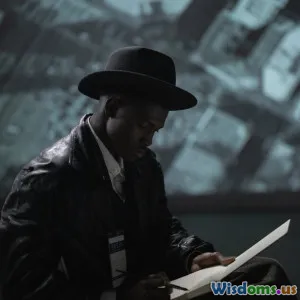
What Makes Relatable Characters Unforgettable in Short Stories
18 min read Explore key elements that make short story characters relatable and unforgettable, with practical examples and expert insights for writers. (0 Reviews)
What Makes Relatable Characters Unforgettable in Short Stories
What transforms a character from a mere name on a page to someone who lingers in the reader’s mind long after the final sentence? For short stories—where every sentence counts—the answer often lies in the art of relatability. Readers crave connection, and characters who mirror our fears, hopes, and contradictions have the power to make even the briefest tale unforgettable.
Let’s explore the essential ingredients that turn relatable characters into unforgettable hallmarks of short fiction.
Authentic Emotions Spark Connection

Authenticity is the lifeblood of any relatable character. In short stories, where brevity demands economy, every emotion must ring true. But what exactly makes a character’s feelings feel real rather than fabricated?
The Power of Vulnerability
Consider Raymond Carver’s characters, often ordinary people wrestling with loneliness or regret. In his short story “Cathedral,” the narrator is initially abrasive and insecure, masking his discomfort with snide remarks. Yet when he experiences genuine vulnerability—allowing a blind man to guide his hand in drawing—the emotional payoff feels earned and uncontrived. This vulnerability is highly relatable; readers recognize themselves in these moments of uncertainty, embarrassment, or longing.
Subtlety Over Melodrama
Unforgettable characters express emotions not through grand gestures, but through small, believable moments. For instance, in Jhumpa Lahiri’s “A Temporary Matter,” the disconnect between a grieving couple is signified by the simple act of switching off the lights. Their mundane dinner, peppered with hesitant confessions, reveals deep wells of sorrow and hope. Their subtle gestures—the pause before an apology, the clearing of a throat—invite readers into the nuances of their internal world.
Tip: To render emotions memorable, choose telling details over direct statements. Instead of, “She was angry,” show us the clenched fists, the tapping foot, or the biting retort—all in service of implication, not instruction.
Flaws and Complexity Foster Recognition

No one relates to perfection. Deeply cherished characters are riddled with contradictions, uncomfortable motivations, and inconsistencies that mirror real life.
Lovable Imperfections
Think of Roald Dahl’s Matilda—a prodigiously gifted girl with an outsized thirst for justice, but also a penchant for mischievous retaliation. Then there’s Shirley Jackson’s protagonist in “The Lottery”—a character slowly revealed through their routine interactions, friendly yet unwittingly complicit in community horror. These short story protagonists are memorable because their flaws aren’t flaws for their own sake: they allow readers to recognize aspects of themselves.
Contrasts Create Layers
A mark of great short fiction is the smooth interplay of strengths and weaknesses. Consider Tim O’Brien’s “The Things They Carried.” The characters are defined by their burdens—both physical and emotional—displaying courage next to fear, tenderness next to violence. The protagonist, Lt. Jimmy Cross, is at once a devoted leader and a distracted dreamer, simultaneously admirable and heartbreaking. This layered approach makes him stick in the reader’s memory; he is not reducible to a stereotype.
Actionable Advice: Give characters a motivating flaw. An impulsive nature, a secret prejudice, a persistent doubt—infusing the story with plausible struggle. These details, revealed in passing dialogue or a hasty decision, offer humanity.
Distinctive Voice and Perspective Breathe Life

A memorable character lives and breathes on the strength of their voice. This is more than just how they speak; it’s how they view the world, layer their thoughts, and reveal their perspectives. For readers of short stories, voice is often the primary means of immersion.
Dialogue as Characterization
Consider the clipped, wholesome dialogue of Hemingway’s “Hills Like White Elephants”: “Would you please please please please please please please stop talking?” It’s simultaneously plaintive and evasive, perfectly capturing the tension between the two main characters. The dialogue, and the silence it surrounds, tells us volumes about their personalities.
Internal Monologue and Worldview
In Alice Munro’s stories, like “Runaway,” internal monologue provides the richest source of relatability. The protagonist’s minute self-examinations, their justifications or self-recriminations, give the reader privileged access to the kind of thinking we all recognize.
How-To: To generate an unforgettable voice, ask yourself two things: How does the character see the world differently? What unique logic or phrasing do they habitually use? Sprinkle this individuality into their reactions, descriptions, and even in their silences.
Purpose-Driven Actions Reveal True Character

When the reader understands not just what a character does, but why they choose to act—or not act—the character’s fate becomes emotionally charged.
Reveal Motivations Early On
Short stories seldom have time for elaborate backstory. Instead, they capture characters at moments of meaningful choice. In James Joyce’s “Araby,” the young narrator’s yearning to impress Mangan’s sister propels the entire narrative. Every action—his anticipation, his nervous visits to the bazaar—emerges from this deeply human motivation. Readers may not recall every plot point, but they remember his disappointment upon discovering the mundanity of reality, a universal coming-of-age moment.
Moral Dilemmas Add Dimension
Great characters struggle with choices, often disappointing themselves. Flannery O’Connor’s “A Good Man Is Hard to Find” hinges on the grandmother’s shifting ethics under threat—a relatable, if uncomfortable, revelation of self-interest. Such moral complexity binds the story to the memory, forcing readers to reflect on their own responses.
Comparison: Flat characters react predictably; unforgettable characters are agents of their own transformation, for better or worse. Motivations act as the story engine and staying power as their legacy.
Specificity Bridges the Gap to Universality

The paradox of relatability is this: The more unique the character, the more universal their impact. Classic characters often stick in our minds because of concrete, specific traits that single them out, yet resonate broadly.
The Power of the Particular
George Saunders’ “Puppy” features Marie, an exasperated mother whose particular blend of guilt and pride—amplified by realistic domestic chaos—makes her simultaneously unique and familiar. The hint of regret in how she disciplines, the distracted tenderness, transforms Marie from a mere archetype to a person we recognize.
Details Over Generalizations
Specific hobbies, memories, or speech patterns are the stuff of enduring characters. Even the classic Sherlock Holmes, though not a short story staple alone, has become unforgettable in part due to particulars: the violin playing, the pipe, the keen eye for the mundane. Apply this formula to short fiction—a character who hums old lullabies while scrubbing floors, or builds intricate model ships, feels tangible in a way that “a kind woman” never can.
Practical Exercise: After drafting a character, add three hyper-specific details—odd habits, particular memories, sensory associations—to anchor them in the reader’s mind.
Interactions: Chemistry that Amplifies

No character exists in isolation; it is the interplay between personalities that often elevates them from memorable to unforgettable.
Dialogue: Tension and Banter
In “The Gift of the Magi” by O. Henry, the central couple’s sacrifices and warm repartee imbue the story with pathos. It’s not only what they say, but the subtext: the anxious half-truths, the loving glances, the resigned laughter. These interactions draw the reader into a relationship they instantly care about.
Secondary Characters as Mirrors
Secondary characters can highlight or challenge traits in the protagonist, sharpening their relatability. A sharp-tongued sibling, a jealous friend, or a wise mentor provide contrast, friction, or resonance. In “Recitatif” by Toni Morrison, the contrasting backgrounds and biases of the two protagonists amplify one another’s complexity, enabling readers to see aspects of themselves reflected in both perspectives.
Tip: Examine your cast for character dynamics that allow friction or support. Each relationship should teach us something about the protagonist that would remain hidden in solitude.
Growth and Change: The Arc of Unforgettability

Enduring characters do not remain static; even in just a few pages, their world, or their sense of self, has shifted by the story’s end. This growth or realization, even if subtle or painful, cements their place in literary memory.
The Micro-Arc
In Saki’s “The Open Window,” Vera’s ability to spin tales—and her sly smile at the story’s conclusion—marks her not just as a trickster, but as a dynamic force within the brief narrative. A single, pivotal scene can redefine reader understanding and attach a memorable label to the character (in Vera’s case, the brilliant raconteur).
Lasting Echoes
The best short stories end with a note of ambiguity or unresolved tension, suggesting further evolution. Louise Erdrich’s “The Red Convertible” offers no tidy conclusion, but the bond between the brothers is altered forever by what has occurred. This sense of growth, paired with unresolved complexity, invites readers to imagine the future trajectory, binding character to memory.
Actionable Advice: Even if your story’s time span is short, consider what the character learns, loses, or unexpectedly gains. Growth can be revealed in a changed opinion, a new openness, or a single uncharacteristic action.
Relatability Through Limitation: What Characters Cannot Have

Sometimes it is not triumph, but lack—of love, of belonging, of justice—that etches a character into the reader’s psyche. Their unfinished journey, the longing in their heart, is precisely what invites projection and empathy.
Unmet Desires
In “Girls at War” by Chinua Achebe, the titular character’s aspirations are foiled by circumstance and a war beyond her control. Readers remember her not only for who she is, but for what she’s denied, for the possibilities she symbolizes.
Barriers as Empathy-Generators
Relatable characters are often defined by constraints—social class, prejudice, fate. Their struggle within these limits gives rise to the most powerful emotions. Think of Amy Tan’s heroines in “The Joy Luck Club” stories, whose inability to bridge cultural and generational gaps connects global audiences regardless of background.
Insight: For short fiction, the negative space—a failed attempt, an unanswered question, an unreachable dream—can prove just as impactful as achievement.
Sensory Immediacy: Grounding Character in the Physical World

Unforgettable characters experience the world with vivid intensity, rooting their narrative in the here and now. Authentic sensory details invite the reader to inhabit their skin—even momentarily.
Grounded in Senses
Edgar Allan Poe’s protagonists sense dread in the chill touch of the wind, hear imagined footsteps on old floors, taste fear in the dryness of their mouths. By activating touch, sound, smell, and taste—as well as sight—writers create memories as tangible as our own.
Physical Reactions
When stories anchor emotion in physical reactions—a skipped heartbeat, a tremulous voice, a hurried step—characters inhabit reality. Touching examples from “Interpreter of Maladies” by Jhumpa Lahiri showcase characters whose anxious handwringing and distracted eating vividly translate emotional states to the body.
Practical Tip: Challenge yourself to weave one sensory detail per paragraph for at least the character’s first scene. This sets the stage for immersive memory.
The Legacy of Relatable Characters: A Reader’s Companion

What truly makes relatable characters unforgettable in short stories? It’s not a single trick, but a harmonious balance of authentic emotion, recognizable struggle, distinctive perspective, purposeful action, meaningful interaction, and tangible limitation. Their flaws make us care, their dreams make us hope, and their small moments of change invite us to keep reading—to remain, in some part, companions in their journey.
As readers emerge from a story—whether melancholic or triumphant—they carry these characters as silent advisors, old friends, or uneasy memories. The lasting power of a short story character is measured not only by recall but by emotional residue; the sense that someone real has been met, if only briefly.
When you sit down to write your own short story, remember: unforgettable characters are crafted in details, presented in contrast, deepened in interaction, and bound to growth. Make your protagonists specific, flawed, purposeful, and alive in every sense—and your readers will remember them long after the final word.
Rate the Post
User Reviews
Popular Posts




















